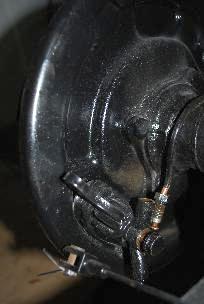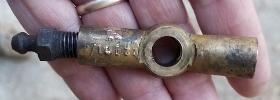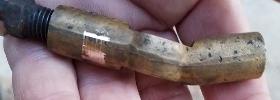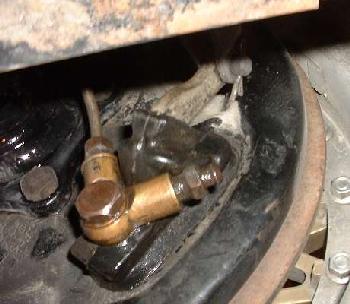The MGA With An Attitude
Rear Brake BANJO and 3-WAY FITTINGS - HT-112
At 09:44 PM 8/10/05 -0400, Mike L wrote:
 "Reassembling my rear 1960 MGA brakes - the parts manual shows the rear cylinder banjo fitting with the pipe coming in from the top and the brake bleed nipple down low. Won't this cause difficulties expelling air bubbles when bleeding?"
"Reassembling my rear 1960 MGA brakes - the parts manual shows the rear cylinder banjo fitting with the pipe coming in from the top and the brake bleed nipple down low. Won't this cause difficulties expelling air bubbles when bleeding?"


No, this is not a problem. The fitting is mounted on a banjo bolt which goes horizontally into the slave cylinder. Regardless of the way the banjo fitting is mounted, the fluid goes in and out the side of the cylinder, not from top or bottom. (This is common for many drum brake slave cylinders). As the bleed bore of the banjo fitting is small and short, air is easily expelled from the fitting during the bleeding process. The more significant issue is that some air may be trapped inside the slave cylinder, especially when the parts are first assembled with no fluid inside.
The tension springs on the brake shoes pull the shoes together when the brakes are released, driving the hydraulic piston and cup seal very near to the blind end of the cylinder, so the internal volume is moderately small. After assembly and initial bleeding of the lines there may be a small amount of air trapped in the slave cylinder causing a spongy feel for the pedal. If clamping the flex hose to stop the flow results in a firm pedal, this is indication of the presence of air in the rear lines or cylinders.
It will help to cycle the brakes a number of times to move fluid in and out of the slave cylinder. This works better if the adjuster cam is slackened off for maximum motion of the shoes to move more fluid through the cylinder. As brake fluid works its way into the cylinder air will work its way out and will accumulate in the higher part of the metal line, and possibly up into the loop of the flex hose above the 3-way fitting. Subsequent bleeding of the brakes will then remove the air from the lines, which in turn eliminates the spongy feel at the pedal. If the spongy feel persists, allow the car to sit for several hours for the air to bubble up and accumulate in a high spot in the lines, and then bleed it again.
"These banjos are pretty well of a straight configuration. I also have from another
 set of MGA banjos that are L shaped. These could be orientated so that the bleed nipple would be higher but would require the pipe to come in from below the axle".
set of MGA banjos that are L shaped. These could be orientated so that the bleed nipple would be higher but would require the pipe to come in from below the axle".
From "Original MGA", at chassis number 27989 for disc wheels and 28540 for wire wheels (1500 cars), threads on the brake lines changed. Earlier threads are 3/8-BSF. Later threads are 3/8-24-UNF, and they are not interchangeable. The 3-way fitting mounted on the rear axle housing and the rear banjo fittings changed threads at the same time. The picture above shows the later style L-shape banjo fitting, right side with the bleeder pointed to the rear. The earlier fitting will have the bleeder pointed nearly straight down. In all cases the fluid line enters at the top.
Addendum November 2007:
Confidential Service Memorandum MG/198, 3rd Jan 1957 notes the change from straight to L-shape rear banjo fitting commencing car number 22741. If the pipe fitting threads didn't change until Mar-Apr 1957, then there may be L-shape banjo fittings with different threads. Otherwise there may be an interim brake pipe with different threaded fittings on opposite ends, or some information is wrong, and these parts may have all changed at the same time. Be alert for thread variations between car no. 22741 and 28539.
Addendum November 24, 2017:
Changes from the MGA 1500 Service Parts List:
3-way piece
AJA5028 - 8H2424 Com. (c)27989 (disc wheels), (c)28540 (wire wheels)
Pipe 3-way to wheel cylinder R/H
AJD30 - AHH5629 Com. (c)27989 (disc wheels), (c)28540 (wire wheels)
Pipe 3-way to wheel cylinder L/H
AJD82 - AHH5631 Com. (c)27989 (disc wheels)
AJD78 - AHH5633 Com. (c)28540 (wire wheels)
Banjo connection
27H7164 - AHH5634 Com. (c)27989 (disc wheels), (c)28540 (wire wheels)
Notice that the rear brake hose did not change. It is the same part used for the front drum brakes. The early 3-way fitting will have 3/8-24-UNF threads in the top port, and 3/8-BSF threads in the side ports. The later 3-way fitting will have 3/8-24-UNF threads in all three ports. The bleeder screw also did not change. The early straight banjo fittings will have 3/8-BSF threads in the top port, and 3/8-24-UNF threads in the bottom port. The later "L" banjo fittings will have 3/8-24-UNF threads in both ports.
|



